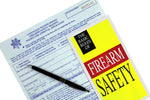In recent years, there has been a significant increase in the number of women choosing to carry concealed weapons for personal protection. This growing trend highlights the importance of selecting the right firearm that suits a woman's unique needs and preferences. With safety and self-defense in mind, choosing the appropriate concealed carry gun is a critical decision that requires careful consideration.
Women are realizing that they have the right to protect themselves and are actively seeking training and education on firearm use. This surge in interest is reflected in the rising number of women obtaining concealed carry permits and embracing the responsibility of carrying a concealed weapon.
The Importance of Choosing the Right Firearm for Personal Protection
Selecting the right firearm for personal protection is paramount, regardless of gender. However, for women, it holds particular significance due to differences in body size, hand strength, and clothing choices. The right firearm should not only be reliable and accurate but also comfortable to carry and operate.
Choosing a concealed carry gun requires thoughtful evaluation of several factors. These include the size and weight of the firearm, caliber selection, ergonomics and grip, sights and optics, capacity and reloading considerations, and trigger characteristics. Each of these factors contributes to the overall performance, comfort, and effectiveness of a concealed carry gun.
By carefully considering these factors and understanding their individual needs, women can find a firearm that fits them both physically and psychologically. A well-suited concealed carry gun instills confidence, allowing women to carry with ease and peace of mind, ultimately enhancing their personal safety.
Factors to Consider When Choosing a Concealed Carry Gun
1. Size and Weight
When it comes to choosing a concealed carry gun, compact and lightweight firearms offer several advantages for women. Their smaller size and reduced weight make them easier to conceal and carry comfortably throughout the day. Compact firearms are typically designed to be more streamlined, minimizing printing and ensuring discretion when carrying concealed. This aspect is particularly important for women who may have different body shapes and clothing styles that require efficient concealment options.
2. Caliber Selection
The caliber of a concealed carry gun directly influences its stopping power and effectiveness for personal defense. It's crucial to select an appropriate caliber that strikes a balance between stopping an assailant effectively and maintaining controllability during rapid follow-up shots. The chosen caliber should provide enough stopping power to neutralize a threat, but not to the extent that it compromises recoil management or makes the firearm challenging to handle.
3. Ergonomics and Grip
A comfortable grip and proper hand fit are crucial for accuracy and control when shooting a concealed carry gun. Women's hands can vary in size and shape, so finding a firearm that provides a comfortable and secure grip is essential. A well-fitting grip ensures proper alignment of the hand with the barrel, allowing for improved recoil management and better control of the firearm during shooting.
There are various grip options available, including interchangeable backstraps, textured surfaces, and ergonomically designed frames. Each option offers different benefits, such as adjustability for hand size, enhanced grip traction, and improved control. Some firearms also offer narrower grips specifically designed to accommodate smaller hands. It's important to try different grip options and find one that feels comfortable and provides optimal control for accurate shooting.

Select the Best Pistol Grip for Your Hand
4. Sights and Optics
Sights and optics play a crucial role in acquiring targets quickly and accurately. A clear and intuitive sighting system is essential for effective self-defense shooting. Traditional iron sights, three-dot sights, or night sights with contrasting colors can enhance target acquisition in various lighting conditions. Additionally, red dot optics are becoming increasingly popular as they provide a fast and precise aiming solution for concealed carry guns.
5. Capacity and Reloading
In self-defense scenarios, having an adequate magazine capacity can be crucial. It provides a higher ammunition reserve, reducing the need for frequent reloads and potential interruptions in the defensive sequence. A higher capacity can also be beneficial in situations involving multiple assailants or when law enforcement response time is delayed.
Reloading efficiently and quickly is vital for concealed carry. Considerations include the ease of reloading under stress, availability of spare magazines, and the ability to access and manipulate the magazine release and slide lock. Additionally, accessories such as magazine extensions or speed loaders can aid in faster reloads. Choosing a concealed carry gun that accommodates these factors can provide added peace of mind and readiness during potential life-threatening encounters.
6. Trigger Characteristics
Trigger characteristics significantly influence accuracy and control of a concealed carry gun. Factors such as trigger pull weight, reset distance, and smoothness can affect the ability to place accurate shots and manage the trigger effectively during rapid-fire situations. A trigger that is too heavy or has a long and vague reset may compromise accuracy and follow-up shot speed, while a trigger that is too light or short may increase the risk of negligent discharges.
Different concealed carry guns offer various trigger options, including those with adjustable trigger weights, shorter reset distances, or reduced trigger reach. These features cater to women with varying hand strength, ensuring they can manipulate the trigger comfortably and maintain control over their shots. It's essential to find a trigger configuration that suits individual hand strength and shooting preferences to maximize accuracy and control.
Popular Concealed Carry Gun Options for Women
1. Compact Semi-Automatic Pistols
When it comes to concealed carry, compact semi-automatic pistols are a popular choice among women due to their reliability and ease of concealment. Some popular models known for their track record of dependability include the Glock 43, Smith & Wesson M&P Shield, and Sig Sauer P365. These firearms have proven themselves in terms of performance, durability, and functionality, making them trusted options for personal defense.
2. Revolvers
Revolvers have their own unique set of advantages and disadvantages when it comes to concealed carry. One significant advantage is their simplicity and reliability. Revolvers are known for their straightforward operation, making them easy to use, especially for individuals new to firearms. Additionally, revolvers are less likely to experience malfunctions or failures, providing added peace of mind. However, revolvers typically have a lower ammunition capacity compared to semi-automatic pistols, and their longer and heavier trigger pull can be a disadvantage in terms of follow-up shots and overall shooting speed.
3. Considerations for Unique Body Types and Clothing Styles
Women with smaller hands or different body types may have specific concerns when it comes to selecting a concealed carry gun. For smaller hands, it's essential to find a firearm with a grip that allows for a comfortable and secure hold. Some manufacturers offer options with interchangeable backstraps or grip panels, enabling customization to fit smaller hand sizes. Additionally, firearms with slimmer grips or reduced reach to the trigger can also be more suitable for women with smaller hands or shorter fingers.
Conclusion:
By carefully considering these factors, women can choose a concealed carry gun that suits their physical and psychological needs. Compact and lightweight firearms are favored for their ease of concealment, while caliber selection should strike a balance between stopping power and controllability. Ergonomics and grip play a crucial role in accuracy and control, and various options are available to accommodate different hand sizes. Sights and optics enhance target acquisition, and magazine capacity and reloading considerations are vital for self-defense scenarios. Finally, trigger characteristics should be tailored to individual hand strength and shooting preferences.




